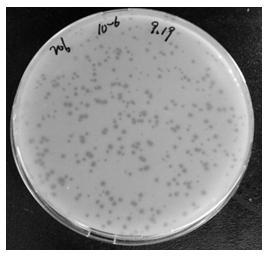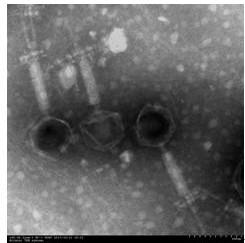Staphylococcus aureus phage strain and application thereof
A staphylococcus and bacteriophage technology, applied in the field of bioengineering, can solve the problem of very few phage research on Staphylococcus aureus
- Summary
- Abstract
- Description
- Claims
- Application Information
AI Technical Summary
Problems solved by technology
Method used
Image
Examples
Embodiment 1
[0024] Phage isolation and preparation
[0025] The isolation procedure of phage is described in detail below. The manure sewage sample in the present invention is collected from Huoshao Li in Changchun City, and the host bacteria is Staphylococcus aureus 206. Collect sewage, filter it with gauze, centrifuge at 6000r / min for 10min, take the supernatant, and use treated sewage instead of ddH2O to prepare TSB medium (100mL); add 1mL of overnight cultured host bacteria 206 to the medium, and incubate at 37°C for 10-12h Take 1 mL of the culture, centrifuge at 12000r / min for 5min, filter the supernatant with a 0.22 μm filter to form a phage stock solution and save it, and use the obtained filtrate for a plaque test to check whether it includes phage capable of lysing Staphylococcus aureus 206.
[0026] Plaque test: inoculate Staphylococcus aureus 206 in 5ml TSB liquid medium at a ratio of 2%, and cultivate overnight at 37°C with shaking. Take 0.1ml of the bacterial culture soluti...
Embodiment 2
[0029] Phage amplification and purification
[0030] On the double-layer plate forming phage plaques, use the tip of a sterile pipette to pick up a single phage plaque with a large diameter, relatively round and translucent, inoculate it in 5 ml BHI liquid medium, and add phage 200 μL of host bacterial solution, mix well, act at room temperature for 15 minutes, incubate at 37°C for 10-14 hours, centrifuge at 12,000 rpm, 4°C for 10 minutes, and take the supernatant; repeat the double-layer plate experiment, and pick a single phage plaque repeatedly in this way for 4-5 times. Phage were purified into plaques of equal size.
[0031] Take 1 mL of freshly cultured host bacteria and add 300 μL of phage lysate (the ratio of a single phage culture to host bacteria is 1:1, 1:10 and 1:100, respectively). Incubate at 37°C for 20 minutes to make the phage particles adsorb to the host bacteria; add 800mL TSB liquid medium, then add CaCl 2 The mother solution was grown to a final concent...
Embodiment 3
[0038] Transmission electron microscope observation of bacteriophage VB_SavM_JYL01
[0039] Take the PEG-purified phage in Example 2 for electron microscope observation. The specific operation steps are: add 10 μL of the sample and drop it on the copper grid, wait for it to settle for 15 minutes, absorb the excess liquid with filter paper, and use 2% phosphotungstic acid (PTA) Stain for 1-2min, observe with a transmission electron microscope (Hitachi H-7650) after drying; the observation results are as follows figure 2 As shown, the head is in the shape of an icosahedron, the diameter of the head is about 90 nm, and the length of the tail is about 190 nm. According to the "Classification of Viruses—The Eighth Report of the International Committee on Taxonomy of Viruses" published by the International Committee on Taxonomy of Viruses (ICTV) in 2005, VB_SavM_JYL01 belongs to Myoviridae.
PUM
| Property | Measurement | Unit |
|---|---|---|
| diameter | aaaaa | aaaaa |
| diameter | aaaaa | aaaaa |
Abstract
Description
Claims
Application Information
 Login to View More
Login to View More - R&D
- Intellectual Property
- Life Sciences
- Materials
- Tech Scout
- Unparalleled Data Quality
- Higher Quality Content
- 60% Fewer Hallucinations
Browse by: Latest US Patents, China's latest patents, Technical Efficacy Thesaurus, Application Domain, Technology Topic, Popular Technical Reports.
© 2025 PatSnap. All rights reserved.Legal|Privacy policy|Modern Slavery Act Transparency Statement|Sitemap|About US| Contact US: help@patsnap.com



